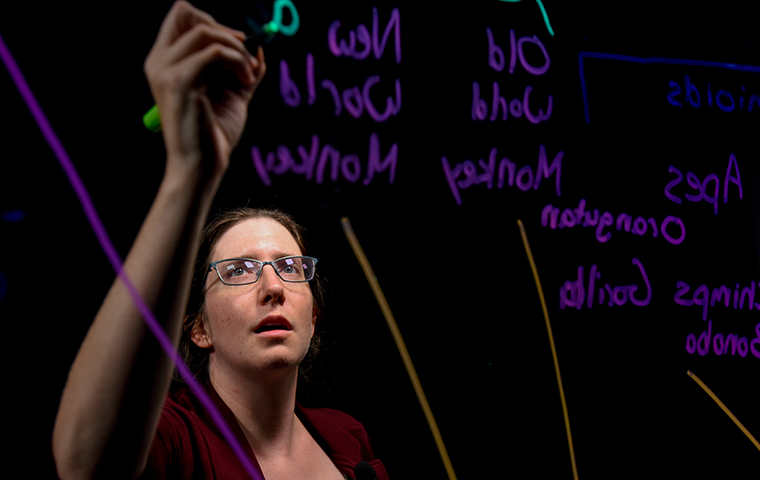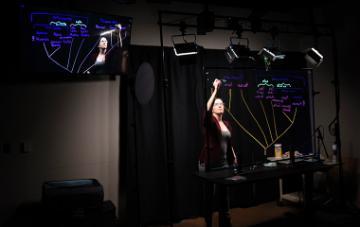
Glass Class
The tech is simple, but the result can be dazzling. Tanya Chiykowski-Rathke explains how Learning Glass makes lectures more engaging.
To truly understand the debate surrounding the authenticity of the Shroud of Turin, you have to get close, lecturer Tanya Chiykowski-Rathke explains to her class via a YouTube video. Like, down in the threads close.
Carbon dating performed by Oxford University on the shroud 30 years ago dated the artifact at 728 years old, a far cry from its supposed origin of 30 A.D. But it’s not that simple. Contamination from soot of burning candles and mended edges could have affected the testing. Same with damage from an earthquake in the 1300s. The shroud also survived a fire in 1532, when Marguerite d’Autriche’s silver casket melted on top of it.

Behind the Scenes: Tanya Chiykowski-Rathke films one of her lectures in the Learning Glass Studio.
Suddenly the hard results of the Oxford testing aren’t so hard. There’s room for debate and discussion.
“I encourage you to go look at the physical studies that have been used to date the shroud,” Chiykowski-Rathke says. “But don’t just look at the science, look at the humanistic approach. How have religious leaders talked about this as a symbol of faith? And as yourself, what role does science play in verifying religion?”
Originally, this lecture on the Shroud of Turin was scheduled to be a typical class. But when a conference conflicted with the normally scheduled time, Chiykowski-Rathke improvised. She filmed a quick lecture in the Learning Glass Studio located next to Media Services on the first floor of the University Library and posted it to YouTube so she could share with her class.
But the video wasn’t just convenient, it added depth. The Learning Glass allowed Chiykowski-Rathke to easily sketch out a timeline of the shroud’s history, display slides from her PowerPoint deck, and draw thread patterns without breaking eye contact with her virtual classroom.
“Normally we would’ve just typed up the lecture,” Chiykowski-Rathke explains. “It would’ve been very boring.”
Learning Glass is a version of lightboard technology developed in 2014 after a San Diego State University study showed students performed better, retained more information, and preferred lightboard instruction over other instructional video formats—and even traditional classroom setups.
The tech behind Learning Glass isn’t complex, but the effect is cool. The panel of glass is lined with bright light-emitting diode (LED) lights along the bottom and top of the glass to reflect light within, allowing the presenter to draw using a fluorescent marker that makes the notes pop. Cameras positioned on the opposite side of the glass flip the image so the text can be read by the video audience.
Chiykowski-Rathke learned about the technology through a workshop hosted by the SCU library and has been quick to incorporate it into her teaching. In addition to hosting virtual lectures when in-class meetings aren’t possible, she’s used it to supplement work and spark further discussion online. Her experience with the technology backs up the study’s finding on engagement.
“Anything is better than just talking,” she says. “Static images are good but if you can add to it so they’re seeing the direct connections, it helps. You can write key words or key dates so they can touch back into the bigger picture or the timeline.”
Success with Learning Glass encouraged Chiykowski-Rathke to try other forms of technology available in the library, too. For example, the green screen technology available in the library—coupled with a 360-degree camera in the field—will allow her to virtually take students to remote dig sites that they likely would never travel to on their own.
Archaeology is an often misunderstood profession, Chiykowski-Rathke explains, and she says that isn’t always the fault of the general public. She thinks using technology like Learning Glass can help bridge that gap.
“That’s one thing we talk about,” she says. “Sometimes we can do a better job of telling our story digitally and in a way people want to consume.”
Lecturer Tanya Chiykowski-Rathke uses technology like Learning Glass to add depth to her archaeology lectures.